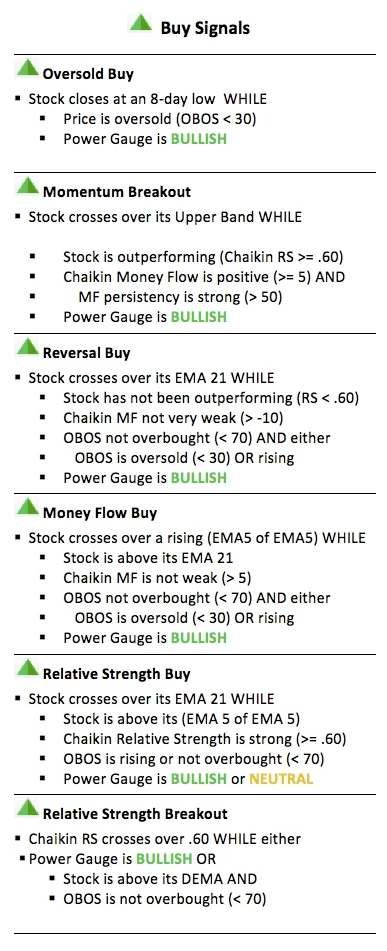Buy and Sell Signals in the Chaikin Analytics system are defined by a triggering event plus supporting conditions. Key conditions are noted – other filter criteria are included to improve the effectiveness of each Signal.
Buy/Sell Signals should be considered a “call to attention” and potentially a call to action, subject to more in-depth review of a stock. (In other words, do not automatically drop everything and Buy or Sell a stock just because a Signal triggers. Further research is always appropriate.)
You can use Signals in 2 ways:
- To screen a larger universe for trading candidates.
- To provide confirmation of an entry or exit point for a stock you are monitoring.
| Signal | Description |
|---|---|
| Oversold Buy/Overbought Sell | Stocks at potential short-term reversal points. |
| Momentum Breakout/Breakdown | Stocks which have broken out of a trading band with momentum likely to continue. |
| Reversal Buy/Sell | Stocks reversing direction relative to the market, with momentum likely to continue. |
| Money Flow Buy/Sell | Stocks with strong money flow and short-term momentum likely to continue. |
| Relative Strength Buy/Sell | Stocks outperforming (or underperforming) the market, with momentum likely to continue. |
| Rel. Strength Breakout/Breakdown | Strong (or weak) stocks which have started to outperform (or underperform) the market. |
Chaikin Analytics provides 6 pairs of daily Buy & Sell Signals which combine technical indicators with the Chaikin Power Gauge Rating to indicate potential trading entry and exit points. Chaikin Buy/Sell signals are calculated as follows:


Notes on Signal Calculations:
- Signals are computed after each trading day when new closing data is received, generally by 11:30pm EST each weeknight. They do not change intraday.
- Calculations are based on market data and Power Gauge Ratings at the time of calculation, and are valid until the next trading day’s closing data is received.
- Ratings are updated before the following open and may change after Signals are calculated.
- ETFs may only trigger Relative Strength Signals.